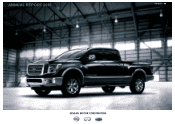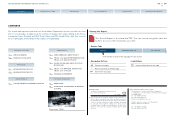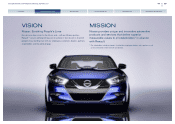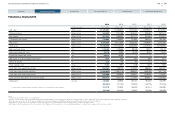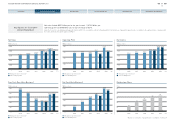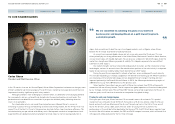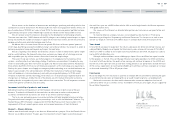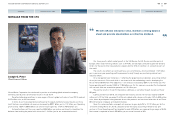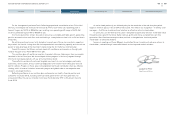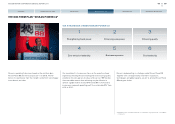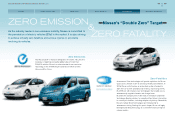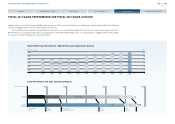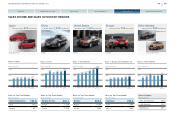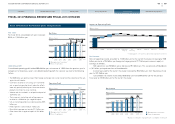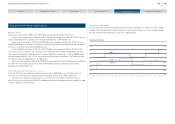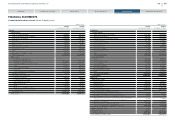Nissan 2015 Annual Report Download - page 7
Download and view the complete annual report
Please find page 7 of the 2015 Nissan annual report below. You can navigate through the pages in the report by either clicking on the pages listed below, or by using the keyword search tool below to find specific information within the annual report.
Nissan remains at the forefront of zero-emission technologies, producing and selling vehicles that
contribute to a cleaner environment. The Nissan LEAF, the world’s most popular all-electric vehicle, will
pass the milestone of 200,000 unit sales in fiscal 2015. Our zero-emission product portfolio has been
augmented by the launch of the e-NV200 light commercial vehicle and the Venucia e30 in China.
Nissan has been one of the foremost advocates for the development of recharging networks.
There are now more than 14,000 electric vehicle (EV) chargers, not including home-chargers, in Japan.
During fiscal 2015, the number of chargers in Japan will increase even further, and we will continue to
develop our battery and vehicle technologies even further.
We believe that, in the near future, Nissan can provide EV drivers with even greater “peace of
mind” range, by offering comparative mobility to today’s conventional vehicles. Our research is aimed at
delivering exceptional range, well beyond anything on the road today.
Nissan is exploring new materials and chemistry solutions in order to make thinner, lighter weight
and less costly batteries. We foresee the day when you leave your home with a full charge, and are
able to go about your day with no concerns then return home with ample charge.
The current fiscal year will also see further progress in the deployment of Autonomous Drive
systems – another pillar of our technology strategy. It reinforces our commitment to leading the way
toward a “zero-fatality, zero-emission” future. Our goal is for Nissan to be ready to deliver Autonomous
Drive vehicles by 2020. Until then, we will introduce components of this technology on a regular basis.
Starting this year in Japan, we will apply our emergency-brake technology as a standard feature on our
highest volume models. This will be followed in 2016 by the introduction of traffic jam technology,
which will enable cars to drive autonomously and safely on congested highways. In 2018, we will
introduce multiple-lane controls technology, which allows cars to autonomously negotiate hazards and
change lanes on highways. And by the end of the decade, we will introduce intersection-autonomy,
enabling vehicles to negotiate city cross-roads without driver intervention. This will empower customers
to drive with greater confidence, ease and safety.
Increased visibility of products and brands
Delivering innovative, exciting products and technologies will continue to be the core of Nissan’s
business. To realize the full benefit of these activities, we also need to make sure that potential
customers are familiar with our brands and aware of our vehicles and technologies.
That is why we are backing up our monozukuri activities with bold, targeted kotozukuri activities.
One particular area of strength is our sports partnerships, such as with the Yokohama F-Marinos, City
Football Group, UEFA Champions League and Infiniti Red Bull Racing, which have resulted in the
improvement of Nissan’s overall opinion scores and increased awareness of the Infiniti brand.
Renault – Nissan Alliance
Another area of continued strength is our focus on Alliance-driven synergies. Since the Renault-Nissan
Alliance was established almost 16 years ago, it has become the fourth-largest automotive group in
the world. Last year, we sold 8.5 million vehicles. With a total of eight brands, the Alliance represents
10% global market share.
The success of the Alliance has attracted other partners, but we know we can grow further and
achieve more.
To maximize Alliance synergies, last year, we converged four key functions in Purchasing,
Manufacturing and Logistics, Engineering; and Human Resources. This has put us on track to over
achieve our target of a minimum of 4.3 billion euros in synergies by the end of fiscal year 2016.
Year ahead
In fiscal 2015, we expect to outperform the industry sales pace and deliver record-high revenue and
solid profitability. Globally, we anticipate that total industry sales volumes will increase 0.1% to 85.4
million units. With a number of new models launching from Nissan and Infiniti, we project our sales to
rise by 4.4% to 5.55 million units.
Although market conditions remain challenging in Japan, Russia and Brazil, we expect to make
further progress in the US, China and Europe. We also have high expectations for Infiniti and Datsun.
As a result of all these factors, the quality of our earnings will continue to improve in fiscal 2015 and
that we are on the right track with our mid-term strategy. Based on our performance outlook for fiscal
2015, and our expectations for continued profitability and solid free cash flow, we project an increase
in the annual dividend by 27% to 42 yen per share.
Conclusion
Nissan has begun this new fiscal year in a position of strength. We are committed to achieving the goals
of our mid-term business plan and keeping Nissan on a path toward long-term, sustainable growth.
We have the resources, the talent and the determination to meet our objectives. And we will
continue to deliver for our customers and our shareholders. Thank you, once again, for your support for
Nissan Motor Corporation.
C a r lo s G h o s n
President and Chief Executive Officer
Nissan Motor Co., Ltd.
06
NISSAN MOTOR CORPORATION ANNUAL REPORT 2015
TOP MESSAGE
CONTENTS
NISSAN POWER 88
PERFORMANCE
CORPORATE GOVERNANCE
CORPORATE FACE TIME

